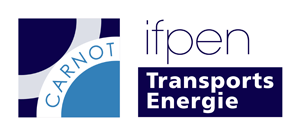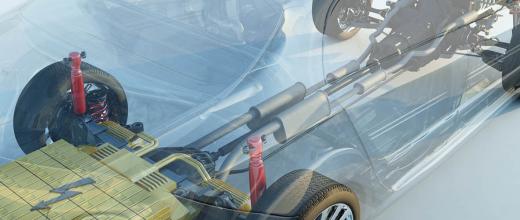 Electrified Mobility
Electrified Mobility
OUR solutions
The electrification of the transport sector is gathering momentum. To support the trend, IFPEN is working on the various building blocks of the powertrain, focusing on specific experimental resources:
• Electric machines and their management (power and control electronics)
• Batteries: modeling and simulation
• The fuel cell
• Electrification of the air loop
Electric machines and their management
Electric vehicles are a favored solution to reduce the CO2 emissions associated with road transport. IFPEN is working on the design of high-performance powertrains. Its research has led to the selection of synchronous reluctance motor technology, which has a triple advantage:
- it uses fewer magnets, and hence rare earths, than the permanent magnet synchronous motor,
- its production cost is therefore lower,
- it is highly efficient compared to motors currently marketed.
e-Mod-Tools: a disruptive tool for optimal electric machine design
IFPEN has developed e-Mod Tools (electric Motors Optimal Design Tools), an electric machine design optimization software suite. The tool makes it possible to generate a large number of virtual solutions using IFPEN’s supercomputer capacities and then propose a concept reconciling multiple constraints (performance, industrial feasibility, the use of rare earths, cost, etc.). The purpose is to achieve the optimal and robust design of the active parts (stator and rotor) to address the constraints of a targeted industrial application.
As a result, the time required to design a new electric motor has been considerably optimized: now, an advanced concept can be developed in just a few days!”
Misa Milosavljevic, Electric Powertrains project manager, IFPEN
A synchronous reluctance motor for high-performance retrofit
IFPEN and French SME EREM are working on the development and industrialization of highly efficient permanent magnet synchronous reluctance motors for high-performance retrofit applications.
“We decided to develop synchronous reluctance electric powertrain technology with our partner EREM to meet two primary objectives:
- Develop a highly efficient, modular and robust motor able to cope with extreme operating conditions. This involved:
- Maximizing torque density and specific power while incorporating the constraints imposed by the application.
- Creating a compact, robust and modular mechanical design.
- Optimizing engine cooling while minimizing losses.- Identifying the most attractive performance / cost / manufacturability compromise for this type of market. Synchronous reluctance technology offers the best cost / performance / efficiency compromise so we opted to focus on it. However, it demands advanced electronic control and more complex engine torque management to compensate for the small number of magnets: hence we have developed the appropriate control laws.”
Wissam DIB, Electric Powertrains project manager, IFPEN
The first market launch of this research concerns a retrofit application involving machines produced by EREM. These motors develop a maximum torque of around 350 Nm and a power of 150 kW at 350 V.
Ultimately the ambition is to propose, with the same technology, a broader range of motors in terms of power and voltage (from 40 kW at 48 V to 300 kW at 700 V) in order to meet the needs of a rapidly developing electric and hybrid vehicle market, including the electric retrofit market.
High power density at low voltage
To meet the needs associated with the electrification of the vehicle fleet, IFPEN has developed disruptive engines, incorporating compact electronics of up to 40kW. These low-voltage powertrains (36 to 60V) deliver an adequate level of power while retaining a simple electric architecture (low voltage), which represents an electric traction solution suitable for light urban vehicles. Moreover, this solution makes it possible to incorporate a bigger electric component in hybrid vehicles (extension of the ZEV).
Electric machine management
“IFPEN has created a development environment dedicated to the design and validation of command laws for the management of electric machines, capable of automatically generating the code that will be integrated in the management electronics (inverters). This environment makes it possible to design and calibrate the algorithms necessary for the precise management of electric machines operating at high speed, characterized by a high electric frequency. The software solutions developed are embedded in a control card, integrated into all inverters developed and produced by IFPEN. These inverters address a broad range of applications, from low-voltage 3 or 6-phase machines (Mosfet 48V inverters) to high-voltage machines (400V IGBT or 800V SiC inverters). The combination of high-performance algorithms and compact electronic systems characterized by small losses makes it possible to exploit the potential of the new-generation electric machines designed by IFPEN or those of its industrial partners. IFPEN is pursuing its efforts in this field with the adoption of GaN power components in order to master their implementation in inverters and their specific management characteristics.”
Gianluca Zito, Electric Powertrains Manager, IFPEN
Batteries: modeling and simulation
With more than ten years’ experience in the study, characterization and modeling of electrochemical storage systems (ESS), IFPEN is today recognized as a leading player in battery modeling and simulation in France. Alongside its original research targeting transport applications, its activities have now been expanded to cover stationary applications, a fast-evolving field in which the aim is to develop increasingly efficient batteries.
“Battery modeling is central to our research in the field of ESS. Our models are constantly enhanced and are capable of representing the electrothermal behavior of ESS and their aging, and even abuse mechanisms, thanks to the accurate modeling of the thermal runaway phenomenon for Li-ion batteries.
Thanks to active intelligence gathering and our involvement in networks such as RS2E in France, we keep our models up to date for the most recent commercial battery and prototype technologies.
Battery modeling requires:
- the implementation of mathematical approaches that can be simple (empirical by electrical analogy) or highly complex (physical models, ab initio methods) depending on the needs of the end users.
- access to test facilities and related tools (mathematical processing, data management, sensitivity analyses, etc.) enabling the effective calibration of parameters associated with the models and their validation.
Since aging tests to calibrate durability models are particularly costly in terms of time and resources, we initiated the creation of the COMUTES² consortium, set up to organize pooled test campaigns open to all.”

Julien Bernard, Battery project manager, IFPEN
Points to remember
IFPEN's battery models are available in the Electric Storage library of the Simcenter Amesim platform (see below).
They are used:
- for research conducted by IFPEN to support industry: choice of technology, dimensioning for an application.
- Within the context of collaborative projects to accelerate the development of the electric sector.
- To innovate in areas of current interest such as rapid recharging, the second life of batteries, new generations of solid-state batteries, etc.
“The Electric Storage library we are developing with our partner Siemens Digital Industries Software, integrated in the Simcenter Amesim™ platform, offers users assistance for:
- the pre-dimensioning of the battery pack, thanks to a tool that enables a few macroscopic data to be used to generate a first Li-ion battery design and its associated model
- the automatic calibration of their battery models, on the basis of experimental measurements
- and the evaluation of complex phenomena, such as aging or thermal runaway.”
Grégory Font, Powertrain system modeling project manager, IFPEN
THE FUEL CELL
The fuel cell represents an alternative to batteries as a power source for electric machines, associated with an increased vehicle range and much faster recharging times. IFPEN and its partners are working on a fuel cell system approach in the vehicle environment, focusing, in particular, on the optimization of the system’s energy management and on cost reduction, using unique digital and experimental resources. A new test bench capable of testing fuel cell systems up to powers of 210 kW has been operational at the Lyon site since the fall of 2021.
Find out more
Electrification of the air loop
An electric turbocharger for hybrid vehicles
To further increase vehicle performance and reduce their energy consumption, IFPEN has developed an original turbocharger electrification solution (4kW at 48V) that could be used in future hybrid vehicles.
“There are two main advantages with an electric turbocharger:
- improved drivability thanks to enhanced engine dynamic performance,
- reduced fuel consumption and (CO2) and increased electric range via recovery of lost exhaust energy recovery in stabilized operating conditions (road or highway).
Thanks to development covering the entire electric system (motor, sensorless high-speed control and inverter), we are able to propose an original and innovative electrification system that adapts to the various turbochargers on the market.”
Fabrice Le Berr, head of the Electric Systems Department, IFPEN
The ORC turbine
Stationary energy recovery
IFPEN and Enogia, a French SME specializing in ORC (Organic Rankine Cycle) thermal energy recovery systems, have developed the ORC-100 system (100 kWe). The system makes it possible to recover the heat lost by large stationary installations (2 MWth) and convert it into electricity. It forms part of Enogia’s range of solutions covering powers from 10 to 200 kWe.
Heat recovery from heavy truck engines
Building on previous research, IFPEN and French SME Enogia are developing a low-power version (4-5 kWe) of these ORC systems for hybrid heavy trucks, in order to adapt the technology for the transport market.
“ORC systems make it possible to recover the heat lost and convert it into electrical energy. Used for many years for stationary applications, we are adapting them to the transport sector, particularly for heavy trucks. With the advent of heavy truck hybridization, electric production will make it possible to recharge the battery and provide an extra degree of freedom to the energy management law to reduce fuel consumption and CO2 emissions. We are targeting reductions of between 1.5 and 3% in long-distance operating conditions. The original aspect of our approach is that, rather than being recovered from the exhaust gases, the heat is recovered from the engine’s cooling system, despite the temperature being lower there. This will make it possible to make the system lighter, more compact, cheaper, more reliable and easier to integrate while drawing lessons from previous ORC research for light vehicles, which, as a result of evolving regulations and the planned discontinuation of IC powertrains for light vehicles in 2035, is no longer a relevant solution.”
Benjamin Réveillé, project manager, IFPEN
IFPEN is also working with Enogia, VNF, NaviWatts and Malcuit Transport Fluvial on the development of a demonstrator on a 110-m self-propelled river boat. The objective is the hybridization of the boat with the following renewable energy solutions: 40kWe ORC, solar panels and batteries in order to reduce recourse to the onboard electric generator and thus CO2emissions. One of the advantages or the river environment for ORC is access to an abundant cold source: water.









